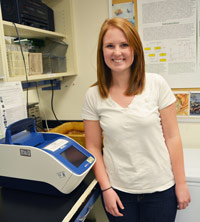
Name: Hannah Jesberger
Education: B.S. in Zoology with minors in conservation biology and Spanish at Colorado State University
Hometown: Spokane, Washington
Career goal: Research endangered species conservation.
Favorite Memory: Unpacking crates of crabs with lab mates. “We get 700 at once and they come in these huge crates ... you just kind of have to stick your hands in and grab the crabs,” Hannah laughs. “It’s actually really fun.”
Project: Cloning Crustacean Hyperglycemic Hormone in Dungeness Crab, Metacarcinus Magister.
Hannah works to clone, or find the sequence for, the Crustacean Hyperglycemic Hormone (CHH) gene in dungeness crabs. CHH is a stress indicator that shows how an animal reacts to its environment. Understanding more about the gene can lead to further experiments. “A lot of its functions aren’t really known, so if you have the sequence it’s a lot easier to study the gene,” Hannah reveals.
The CHH gene occurs in other crustaceans as well, and scientists have already sequenced the genes for other animals. These sequences’ similarities to the crab genome allow Hannah to select primers, or chemicals that attach to DNA and help copy certain segments, to use in a Polymerase Chain Reaction (PCR) machine that makes thousands of copies of DNA segments at once. Hannah runs the results through a gel to separate the DNA fragments and then sends them to the UC Davis Bodega Marine Laboratory to identify the fragments. She then compares the segments and puzzle-pieces them together to reveal the full sequence of the gene.
Primary Investigator
Undergraduate
- Matt Donovan
- Talia Head
- Hannah Jesberger
- Hanna Schulz
- Kent Schnacke
